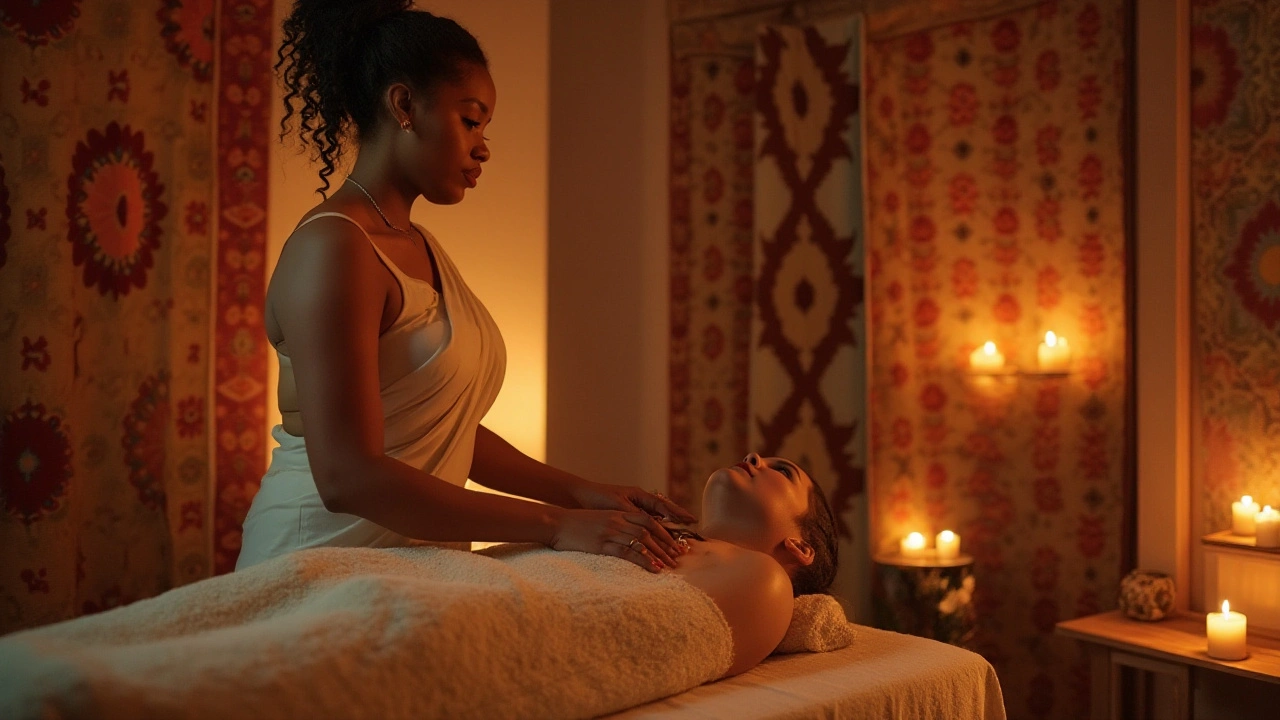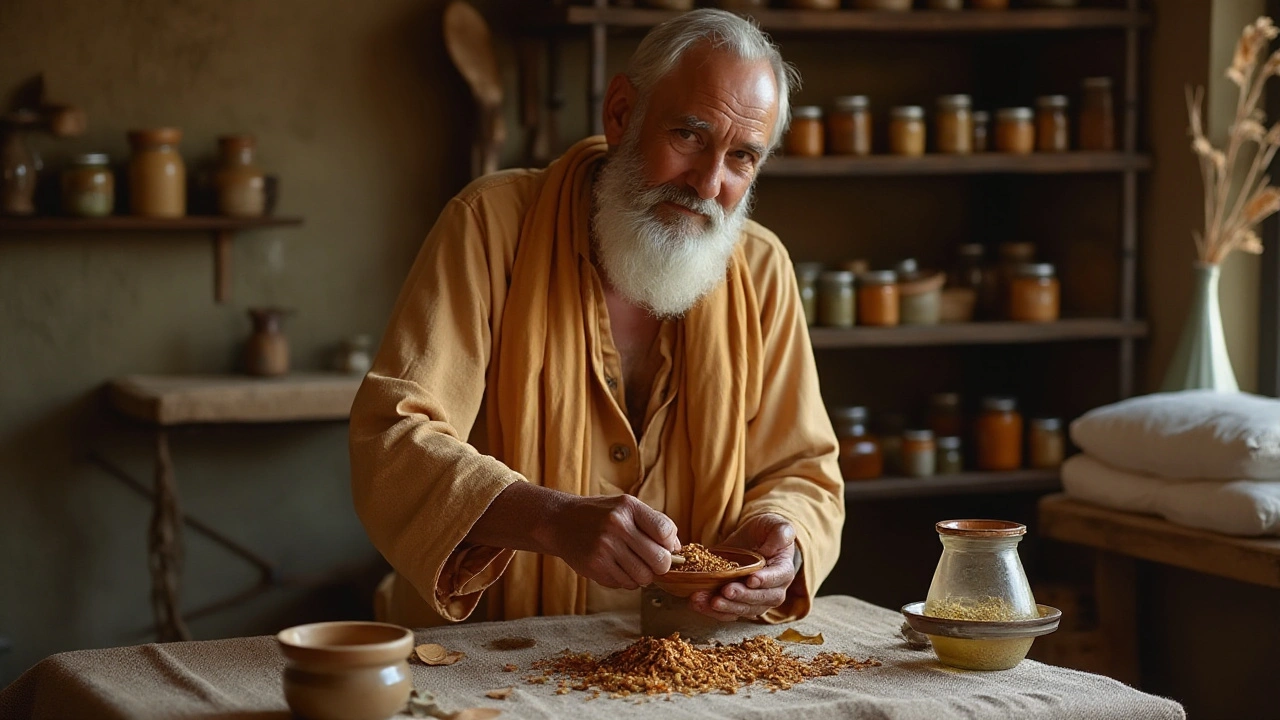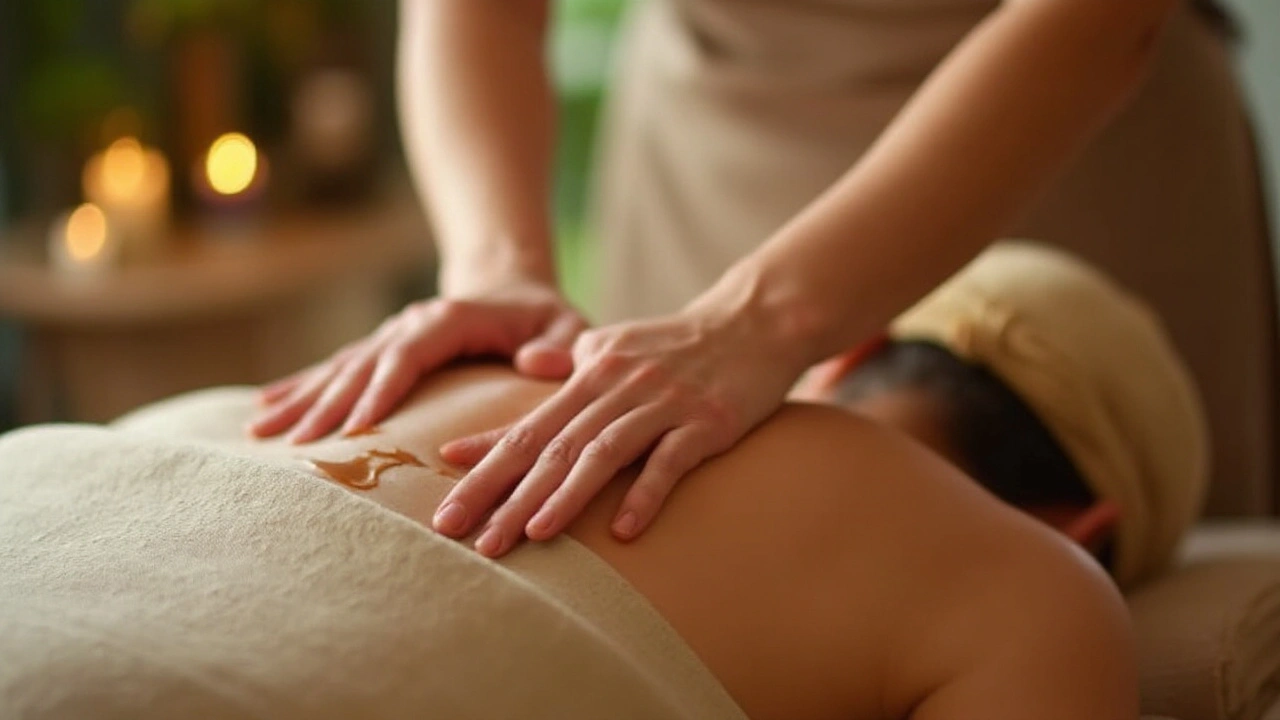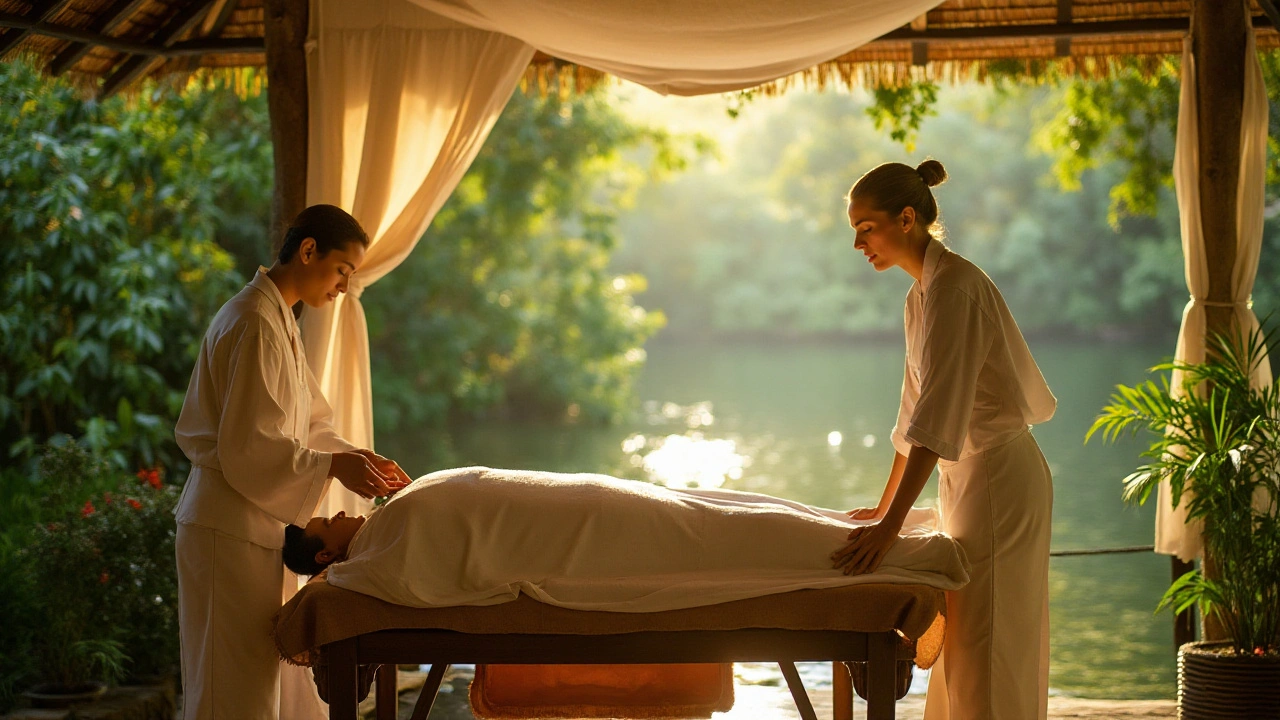Discover the Magic of Ayurvedic Massage for Healing and Wellness
 Sep, 1 2024
Sep, 1 2024
Ayurvedic massage might be one of the oldest forms of therapy that humankind has known, yet its benefits continue to impress and attract people around the globe. This timeless practice from India offers a unique blend of physical, mental, and spiritual healing.
Ayurveda, which translates to 'the science of life,' forms the backbone of these massages. Crafted to harmonize the body's energies, Ayurvedic massage is grounded in a philosophy that dates back over 5,000 years.
In this article, we'll take you on a journey through the history of Ayurvedic massage, explore different techniques and practices, reveal the multitude of health benefits, and share tips to help you make the most of your experience. Whether you're seeking relief from physical ailments or longing for peace of mind, this ancient therapy has something to offer everyone.
- History and Origins of Ayurvedic Massage
- Techniques and Practices
- Health Benefits
- Tips for Getting the Most Out of Ayurvedic Massage
History and Origins of Ayurvedic Massage
Ayurvedic massage has its roots deeply embedded in the ancient Indian system of medicine known as Ayurveda. Originating over 5,000 years ago, Ayurveda is believed to be one of the world's oldest holistic healing systems. The practice focuses on balancing the body's energies, known as doshas, to maintain health and well-being. The sages of India, known as rishis, are credited with the creation of Ayurveda. They meticulously documented their findings in ancient texts called the Vedas, specifically the Atharva Veda—a rich source of Ayurvedic knowledge.
The primary aim of Ayurvedic massage is not just to relax muscles but to harmonize the physical, mental, and spiritual elements of the human body. According to traditional beliefs, the body is composed of five elements: earth, water, fire, air, and ether, which are linked to the doshas—Vata, Pitta, and Kapha. Each person has a unique combination of these doshas, and Ayurvedic massage techniques vary to balance these elements. Over centuries, the practices within Ayurvedic massage have evolved, but the essence remains the same, focusing on holistic health and the well-being of the individual.
Ancient Texts and Manuscripts
The earliest reference to Ayurvedic practices, including massage, can be found in texts such as the Charaka Samhita and the Sushruta Samhita. These texts provide detailed descriptions of various herbs, oils, and techniques used in Ayurveda. For instance, the Charaka Samhita elaborates on the benefits of using specific botanical ingredients during a massage, aimed at detoxifying the body and enhancing circulation. The Sushruta Samhita, on the other hand, extensively covers surgical techniques and other therapeutic practices that complement Ayurvedic massage.
"The science of life, Ayurveda, is not just limited to medicinal benefits but also encompasses the art of living gracefully and healthily." — Charaka Samhita
Ayurvedic massage, often referred to as 'Abhyanga,' was an integral part of daily life in ancient India. It was believed to help align the body's energies, detoxify the entire system, and provide a sense of well-being and calm. Specific massage techniques and oils were selected based on an individual's dosha constitution, ensuring a personalized treatment that addressed unique needs. Traditional Ayurvedic practitioners, known as vaidyas, played a significant role in spreading this art form, and they were often revered as essential pillars in their communities.
Techniques and Evolution Over Time
In ancient India, Ayurvedic massage techniques were typically passed down through generations within families. These methods included various strokes, kneading, and tapping, utilizing herbal oils catered to the individual's dosha. The application of these oils was carefully executed to aid in detoxification and rejuvenation. Some records even indicate that Ayurvedic massage was part of royal treatments among kings and queens, seen as a privileged therapy reserved for the elite classes.
Over the centuries, the influence of Ayurveda spread beyond the Indian subcontinent. Persian, Greek, and Chinese texts document the impact of Ayurvedic practices on their own medical traditions. By the time Ayurvedic massage methods reached the Western world, they had evolved to incorporate aspects of other traditional therapies, while maintaining the foundational principles set forth by ancient Indian sages. This enduring legacy speaks volumes about the efficacy and timeless nature of Ayurvedic massage.
The rich history and origins of Ayurvedic massage underscore its importance as not just a method to relieve physical pain but as a comprehensive approach to fostering a healthy, balanced life. Modern-day practices continue to honor these ancient traditions, making Ayurvedic massage a fascinating, multifaceted therapy that connects us to the wisdom of the past.

Techniques and Practices
Ayurvedic massage stands out not just in its approach to healing, but in the diverse array of techniques that professionals use. At the core, these techniques aim to balance the tridoshas – Vata, Pitta, and Kapha, which are considered the fundamental energies governing our health.
One popular method is Abhyanga, an oily massage that uses a specially formulated herbal oil to nourish and detoxify the body. During an Abhyanga session, practitioners often use long, rhythmic strokes that follow the body’s energy channels. The oil serves multiple purposes: it warms the body, relaxes the muscles, and facilitates the release of toxins stored in the tissues. People who experience Abhyanga often report a profound sense of relaxation and clarity afterward.
Then there's Shirodhara, a unique treatment where warm oil is steadily poured over the forehead, or the 'third eye'. The gentle pouring of oil induces a state of calm and helps to alleviate stress and anxiety. This procedure usually lasts for 30 to 45 minutes and is often followed by a gentle head massage. Dr. Vasant Lad, a pioneer in Ayurvedic medicine, once said, "Shirodhara is a gift to the nervous system."
Another noteworthy technique is Pizhichil, or 'Thaila Dhara'. This luxury treatment combines both oil and heat therapy. Traditionally, two therapists work in unison, pouring warm medicated oil onto the body and simultaneously performing a rhythmic massage. This treatment is especially beneficial for people with musculoskeletal conditions.
Ayurvedic practitioners also often use Marma massage, which focuses on 107 key energy points throughout the body. By gently stimulating these points, the practitioner aims to improve the flow of energy or prana, reducing stress and promoting overall well-being. This method is similar to acupressure in its focus on vital points but follows the unique principles of Ayurveda.
Moreover, Ayurvedic massage techniques are not just confined to the use of oils and touch. They also integrate herbal boluses or 'Pinda Sweda'. In this method, muslin cloth is stuffed with a mixture of therapeutic herbs and dipped in warm oil. The bolus is then massaged onto the body. This technique is especially effective in relieving chronic pain and inflammation.
The effectiveness of Ayurvedic massage relies heavily on the skill of the practitioner. They must be well-versed not only in the techniques but also in the understanding of the client's unique doshic balance. Different oils and pressure techniques are chosen based on individual's constitution and current state of health.
Practitioners are also trained in the use of various herbal concoctions. These herbal blends can be tailored to the client's needs, ranging from anti-inflammatory herbs for physical pain to calming herbs to soothe the mind. This personalization makes Ayurvedic massage a highly customized experience that addresses the unique needs of each person.
Whether it's through a choreographed series of massage strokes, the specific choice of herbs, or the temperature and type of oil used, the aim is always the same: to bring balance and harmony to the body, mind, and spirit. This holistic approach makes Ayurvedic massage not only a relaxing experience but a therapeutic journey back to health and well-being.

Health Benefits
The health benefits of Ayurvedic massage are as varied and profound as the ancient science itself. One of the most instantly noticeable effects is relaxation. The soothing touch and rhythmic movements are designed to calm the nervous system, reduce stress levels, and promote overall mental peace.
But relaxation is just the beginning. Ayurvedic massage is known for improving blood circulation. The specific techniques used help in the efficient flow of blood and nutrients to various parts of the body. Better circulation means better organ function and quicker healing from injuries.
Stress and blood circulation aside, Ayurvedic massage significantly boosts the lymphatic system. It aids in the removal of toxins from the body, known in Ayurveda as 'Ama.' By stimulating lymphatic drainage, these massages enhance your immune system and keep illnesses at bay. It's like a natural detox session.
Many people turn to Ayurvedic massage for chronic pain management. Whether it's arthritis, back pain, or muscle soreness, the massage techniques can alleviate discomfort. The use of specialized oils tailored to your specific needs can penetrate deep into tissues, offering long-lasting relief.
Another remarkable benefit is enhanced skin health. The natural oils used in the massage not only nourish the skin but also act as natural moisturizers. Regular sessions can lead to improved skin tone and texture, making your skin look radiant and youthful.
Mental clarity and improved focus are subtle yet significant benefits. The reduction in stress levels and the harmonious balance created in the body help clear mental fog, making you feel more alert and focused. It's like hitting a mental reset button.
According to Dr. Vasant Lad, a celebrated Ayurvedic practitioner, "Ayurvedic massage is a profound way to connect with the body's innate wisdom and facilitate both physical and emotional healing."
An often overlooked benefit is enhanced sleep quality. The relaxation induced by the massage can lead to deeper, more restful sleep. Many people with insomnia find significant relief through regular Ayurvedic massage sessions.
In summary, the benefits of Ayurvedic massage are multifaceted. They range from immediate physical relief to long-term mental peace. Integrating this ancient practice into your wellness routine could be one of the best investments in your health.

Tips for Getting the Most Out of Ayurvedic Massage
Embarking on the journey of Ayurvedic massage can be a transformative experience, but there are certain things you can do to ensure you reap the maximum benefits from this ancient practice. Here are some useful tips to enhance your massage experience:
First and foremost, it's crucial to find a qualified and experienced practitioner who specializes in Ayurvedic massage. The beauty of this practice lies in its personalization, so an adept practitioner will tailor the session to suit your specific needs and dosha type. Before settling on a massage therapist, take the time to inquire about their qualifications and experience.
It's always a good idea to schedule your massage when you can relax and unwind completely. Choose a time of the day when you aren't rushed with appointments or responsibilities. This allows your mind and body to be fully present during the session, making it easier for you to relax and absorb the healing effects.
Before your massage, make sure you hydrate well. Drinking plenty of water both before and after the session helps in flushing out toxins released during the massage. Additionally, avoid heavy meals right before your massage. A light snack or meal a few hours prior is advisable, as it allows for better digestion and maximum comfort.
Dr. John Douillard, a practitioner of Ayurvedic medicine, once said, "The key to harnessing the full potential of Ayurvedic treatments lies in the individual's engagement with their own healing process." This statement holds true for Ayurvedic massages as well.
Communicating with your therapist is also key to enhancing your experience. Don't hesitate to share your concerns or health issues with your practitioner. They can adjust the techniques and pressure according to your comfort level. If at any point during the massage you feel uncomfortable, speak up. Effective communication ensures that the massage experience is both comfortable and beneficial for you.
One of the unique aspects of Ayurvedic massage is the use of herbal oils, selected based on your body's constitution or dosha. These oils have various healing properties. The warmth and specific oil used can deeply nourish your tissues and balance your energies. To optimize the benefits, leave the oils on your skin for a few hours post-massage if possible. The herbs in the oils continue to work their magic long after the massage is completed.
After the massage, allow yourself some time to rest and relax. Your body has just undergone a rejuvenating process, so avoiding strenuous activities or stressful situations will help preserve the sense of calm and relaxation you've achieved. Many people find that taking a warm bath or practicing gentle stretching can amplify the benefits of the wellness therapy.
Avoid the use of electronic devices immediately after your massage. The blue light from screens can be stimulating, disrupting the sense of tranquility and relaxation induced by the massage. Instead, take some time to meditate, read, or simply sit quietly and reflect on the experience.
Lastly, incorporating other holistic healing practices can complement and enhance the effects of your Ayurvedic massage. Consider adopting a balanced diet, regular exercise, and mindfulness practices such as yoga or meditation into your routine. All these elements can work synergistically, promoting overall well-being and maintaining the balance of your physical, mental, and spiritual health.
By paying attention to these tips, you not only maximize the immediate benefits of your Ayurvedic massage but also support your long-term journey toward holistic health and wellness.
